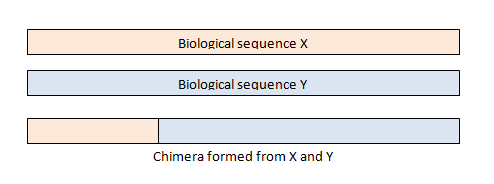| See also UCHIME algorithm Chimeras are sequences formed from two or more biological sequences joined together. Amplicons with chimeric sequences can form during PCR. Chimeras are rare with shotgun sequencing, but are common in amplicon sequencing where closely related sequences are amplified. Although chimeras can be formed by a number of mechanisms, the majority of chimeras are believed to arise from incomplete extension. During subsequent cycles of PCR, a partially extended strand can bind to a template derived from a different but similar sequence. This then acts as a primer that is extended to form a chimeric sequence ([Smith et al. 2010], [Thompson et al., 2002], [Meyerhans et al., 1990], [Judo et al., 1998], [Odelberg, 1995]).
A chimeric template is created during one round, then
amplified by subsequent rounds to produce chimeric amplicons. In 16S sequencing,
we typically find that only a small fraction of reads is chimeric, perhaps of
the order of 1%. However, when reads are clustered into groups of unique
sequences or into OTUs, then we often find that a much larger fraction is
chimeric. This is a challenging problem in sequence analysis because chimeric
sequences are difficult to distinguish from true biological sequences. |
